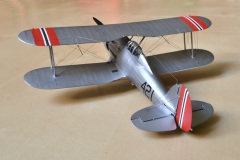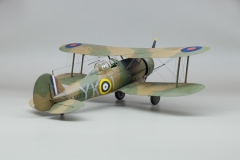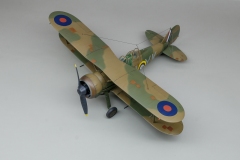Gloster Gladiator Mk.I 1/72 Airfix

The Gloster Gladiator is one of the most famous late 1930s biplane fighters and probably doesn’t need a long introduction. Although the Gladiators were already hopelessly obsolete the moment they entered the service, they were extensively used in combat by multiple countries in many theatres, from Scandinavia to Africa or China. That means there are so many interesting stories to choose from when looking for a particular machine to portray.

I picked the YK-I of No. 80 Squadron RAF, which during the summer of 1940 fought against the Italians along the Lybian-Egyptian border. On August 4th, a small group of Gladiators escorting a single recon Lysander pounced from above on a group of Italian Breda 65s, before being attacked themselves by their escorting Fiat CR.32s. In a resulting fierce WW1-style dogfight, the YK-I pilot Sir Wykeham-Barnes claimed one Breda and one Fiat, before he was shot up by a second Fiat (piloted by a Spanish Civil War veteran and later ace Duilio Fanali) and forced to bale out. Dehydrated and injured, he was fortunately later rescued from the middle of a desert by some British soldiers.

The YK-I shooting down a Breda 65 is featured on the cover of the Gloster Gladiator Aces book by Osprey Publishing.

Wykeham-Barnes fought through the whole rest of WW2, piloting Hurricanes, Tomahawks, and Mosquitos, scoring a total of 14 individual and 3 shared victories. After the war, he had a long career as a high-ranked RAF official and later a politician and also wrote a few books on aviation history. Apparently, he had some interest in scale models as well.😉
By the way, another Gladiator taking part in this dogfight was piloted by no one else than Marmaduke “Pat” Pattle, later the top-scoring Gladiator and Hurricane ace and probably also a top-scoring British Commonwealth pilot overall with 40-60 kills according to various sources. On August 4th, Pattle claimed one kill but also had to bale out and walk back through the desert.

The Pattle’s YK-O Gladiator passing the formation of Breda 65s is featured on the boxart of Roden’s 1/48 kit, created by the late Ukrainian artist Valery Grygorenko.
Apart from Pattle, the 80 Sqn included many other elite airmen, like Nigel “Ape” Cullen or William “Cherry” Vale, and also the famous writer Roald Dahl (who was an ace as well!). Dahl wrote several interesting, very melancholic short stories based on his combat experience, including the description of Pattle’s demise in the battle above Athens in April 1941.
But enough of history, now something about the model. It’s a nice kit, obviously much better than both the Sword shortrun and the “easy kit” by Hobbyboss. The main downsides are very thick clear parts with prominent frames, and also bulged panel fasteners scattered all over the surface, big as 1:1 grapefruits.
I started the build back in 2015 (!!), as a third Airfix Gladiator already. After two relatively simple builds (see above), I went all-out in an attempt to make an ultimate Gladiator. I bought almost all the aftermarket that existed back then – resin wheels and engine by SBS, photoetch by Marabu, many resin bits and pieces by Quickboost, including separated horizontal stabilizers, and a sand filter by Freightdog.
As always with these overly ambitious plans, I burned out quickly. I removed all these panel fastener pimples and replaced them with circles made with a sanded-down syringe needle. That was a chore, obviously. Then I assembled the SBS engine from like 50 separate pieces, which wasn’t that much fun either.

I cut the clear parts, thinned down the windshield and the rear part, and replaced the canopy with a photoetched frame (by far the most important piece of the Marabu PE). I started assembling the photoetched cockpit, but all those metal fiddly bits did me in and I threw the kit away in disgust for several years.

Last May, I took it from the shelf of doom and managed to finish at least the cockpit. The biggest challenge was to align the PE rear bulkhead with the rear clear part.
Recently, I finally finished the rest of the build in about a month. In the end, it was mostly fun, but I must say that 3D printing the engine and cockpit parts instead would probably have been much quicker (even when counting the time spent drawing the 3D models) – but I would feel bad throwing out all the resin and photoetch I bought.🙄 I 3D printed some small stuff, though – the gunsight and the “trumpet” intakes in the engine.

As always, I made the rigging by drilling holes and then threading a painted fishing line all the way through the upper wing.
Most of the paints are Tamiya acrylics (both the Dark Earth and Interior Green are a mix), silver is Gunze C8, and the Dark Green is Gunze H – even though the H paints often make an ugly glossy sticky texture (which can be fixed with a varnish), there are the best for fine, freehand work.
The black-white transition is deliberately a bit fuzzy, as you can see, on the real things it wasn’t too tidy either.
To make the model a bit more interesting, I brush-painted some patches of red dope, inspired by photos like these. Obviously, the harsh desert conditions meant the fabric surface had to be constantly repaired.
All the three photos above are taken from the excellent Alex Crawford’s book published by MMP.
And that’s all. Finishing a kit I started 9 years ago definitely felt like a victory of mind over matter.😅
Any comments, questions, or criticism are welcome as always.















Indeed, this latest model from Mr. Kafka’s workbench is the “Ultimate Gladiator”…. Brilliant, stupendous, and absolutely amazing from prop to rudder and right down to the red dope patch repairs. It’s an amazingly well-researched and beautifully produced version.
Bravo! Nine years was well worth the wait!
p.s. pity the Ba65 suffering yet another indignity